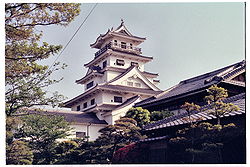
Imabari Domain
Encyclopedia

Han (Japan)
The or domain was the name of the estate belonging to a warrior in Japan after the 17th century. The fiefs of the daimyos of the samurai class of Japan during the Edo period were called han.-Edo period:...
of the Edo period
Edo period
The , or , is a division of Japanese history which was ruled by the shoguns of the Tokugawa family, running from 1603 to 1868. The political entity of this period was the Tokugawa shogunate....
, located in Iyo Province
Iyo Province
was an old province of Japan in the area that is today Ehime Prefecture on Shikoku. Iyo bordered on Awa, Sanuki, and Tosa Provinces. It was sometimes called ....
(modern-day Imabari, Ehime
Imabari, Ehime
is a city located in Ehime, Japan. It is the second largest city in Ehime prefecture.Following a recent merger, the city has an estimated population of 172,384 and density of 410.87 persons per km². The total area is .-Transportation:...
, on Shikoku
Shikoku
is the smallest and least populous of the four main islands of Japan, located south of Honshū and east of the island of Kyūshū. Its ancient names include Iyo-no-futana-shima , Iyo-shima , and Futana-shima...
).
History
Imabari was ruled for most of its history by the Hisamatsu-Matsudaira clan.In 1868, the family was ordered to renounce their Matsudaira name, and instead were ordered to use "Sugawara."
List of lords
- Tōdō clan (1600-1608; tozamaTozamaA ' was a daimyo who was considered an outsider by the rulers of Japan. The term came into use in the Kamakura period and continued until the end of the Edo period.-Edo period:...
; 200,000 kokuKokuThe is a Japanese unit of volume, equal to ten cubic shaku. In this definition, 3.5937 koku equal one cubic metre, i.e. 1 koku is approximately 278.3 litres. The koku was originally defined as a quantity of rice, historically defined as enough rice to feed one person for one year...
)
- TakatoraTodo Takatorawas a Japanese daimyo of the Azuchi-Momoyama period through Edo period. He rose from relatively humble origins as an ashigaru to become a daimyo...
(Period as tenryō intervenes)
- Matsudaira (Hisamatsu) clanMatsudaira clanThe was a Japanese samurai clan that claimed descent from the Minamoto clan. It first originated in and took its name from Matsudaira village, in Mikawa Province . Over the course of its history, the clan produced many branches, most of which also centered around Mikawa Province...
(1635-1871; shinpanShinpan (daimyo)The daimyo were certain relatives of the Tokugawa shoguns of Japan. While all shinpan were relatives of the shogun, not all relatives of the shogun were shinpan; an example of this is the Matsudaira clan of the Okutono Domain. The shinpan lords were also known as kamon daimyō — non-daimyo...
; 30,000->40,000->35,000 kokuKokuThe is a Japanese unit of volume, equal to ten cubic shaku. In this definition, 3.5937 koku equal one cubic metre, i.e. 1 koku is approximately 278.3 litres. The koku was originally defined as a quantity of rice, historically defined as enough rice to feed one person for one year...
)
- Sadafusa
- Sadatoki
- Sadanobu
- Sadamoto
- Sadasato
- Sadayasu
- Sadayoshi
- Sadashige
- Katsutsune
- Sadanori

